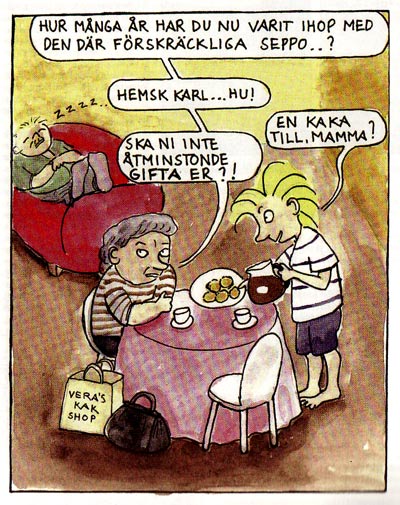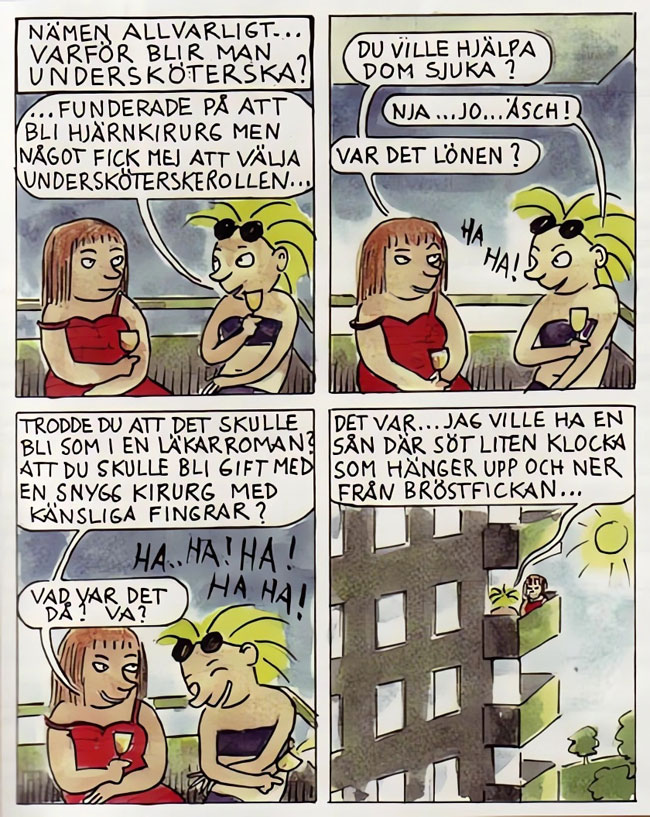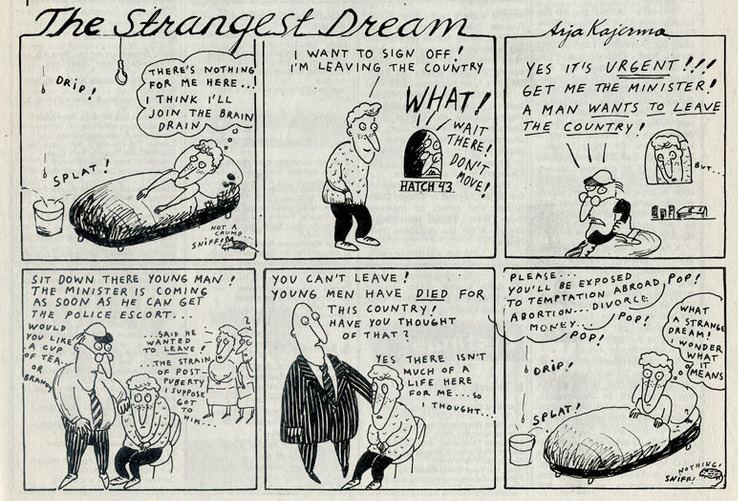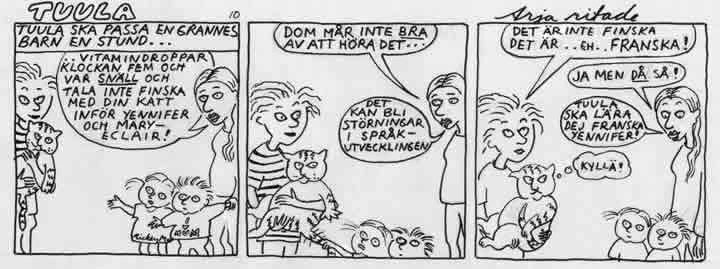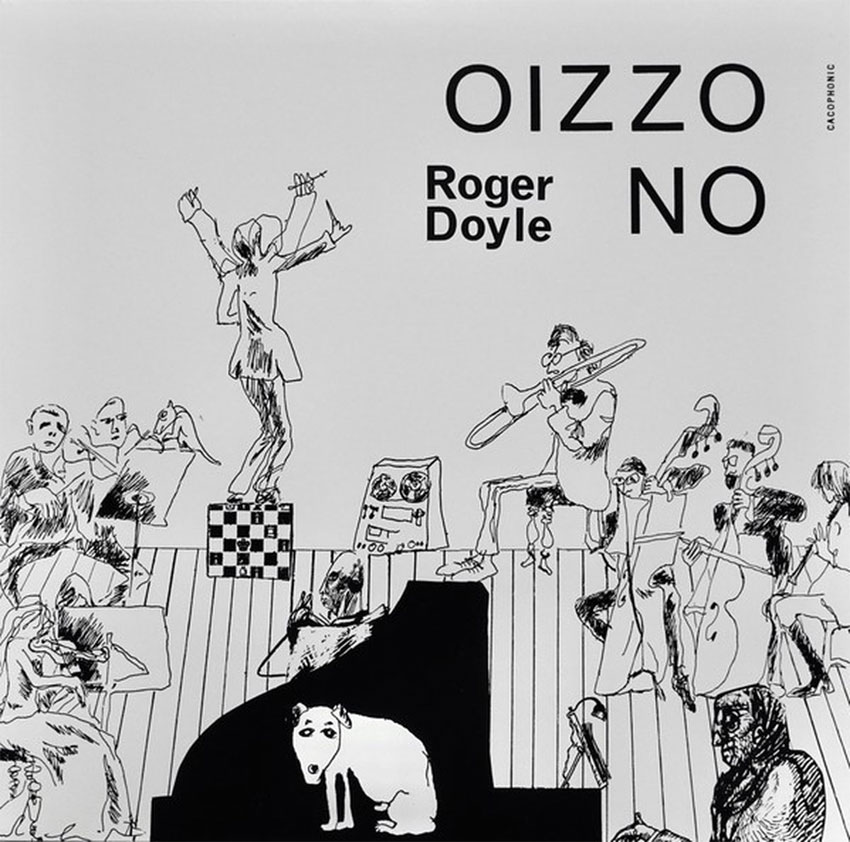'Tuula'.
Arja Kajermo, who also signs with her married name Arja Ritade, is a Finnish-born comic artist with a prominent career in the Irish and Swedish press. Her gag comics were printed in the fortnightly magazine In Dublin, and her comic 'Dublin Four' ran in the Sunday Tribune. Her best-known comic was 'Tuula' (1997-2019), which ran in the Swedish newspaper Dagens Nyheter. This gag series addressed Swedish society from the viewpoint of Finnish immigrants. Kajermo has also been active as a book illustrator and wrote the semi-autobiographical novel 'The Iron Age' (2017).
Early life
Arja Kajermo was born in 1949 in Kiuruvesi, in the eastern Finnish province of Northern Savonia. Her father was a veteran of the Russian-Finnish Winter War (1939-1940) and World War II, and the war experience left him traumatized. Kajermo recalled that her parents often discussed the topic during her childhood. She described it as "the shrapnel that had gone in father's legs (...) had somehow worked its way into his children. Each one of us carried a shard of that iron in our hearts. We would never be at peace."
Kajermo's parents worked as farmers. Despite being a decorated soldier, the Finnish government didn't offer them financial aid: the family lived in considerable poverty. Kajermo recalled that since she never tasted sweets as a child, she was instead addicted to butter. Every winter, her father travelled to Lapland to chop trees in the forest. One day, he noticed that the finest trees were always transported to Russia, to pay off Finland's war debts to the country. Kajermo's father felt very embittered, since he had fought the Russians in the past, only to see them still "profit" from his people. Refusing to be what he called their "slaves", the Kajermo family moved to a suburb of Stockholm, Sweden, in 1955. Only their oldest child remained in Finland to live with his grandmother. Later in life, Arja Kajermo stated that her father never realized that while Finland had to pay off war debts, it also helped the country rebuild its industry, becoming a prosperous nation again by the 1960s.
In Sweden, the Kajermos felt like outsiders. She recalled that she was often criticized by her teachers for being short-tempered, while Swedish children mocked her because of her Finnish accent. Since her parents were poor, her simple, non-luxurious clothing made her stand out. Kajermo remembered that she was initially reluctant to learn Swedish. For a long while, she hoped they would one day return to Finland, though she later stated that there was no proof that she would have been happier growing up there. Eventually she became a true polyglot, studying English, Finnish, Russian and other Nordic languages at the University of Stockholm. She also had an interest in art, ranking the Flemish Primitives among her prime graphic influences. As a child, Kajermo enjoyed drawing houses and princesses. In interviews, she recalled that her graphic skills offered her escapism and immense joy, "almost comparable to getting high". If she hadn't become a comic artist, she would have become an art restorer.
In 1969, Arja Kajermo moved to Dublin to work as an au pair. Originally she intended to stay for only five months, but she kept returning to the country, until finally settling there. In 1982, she married a Northern Irish man, with whom she had two children.
'The Strangest Dream' (In Dublin, 18 September 1986).
Early cartooning career
Kajermo's cartooning career started in In Dublin, a magazine appearing every two weeks, for which she drew a two-strip gag comic in the 1980s. Episodes were observational comedy, often based on current events, and compiled in the book 'The Dirty Dublin Strip Cartoons' (Poolbeg Press, Ward River Press, 1982). Her other comics and cartoons ran in Image Magazine, The Irish Times, Magill, The Sunday Press. Kajermo's comic 'Dublin Four' ran in the Sunday Tribune. She also illustrated the annual 'Women's Diary' for the feminist publishing company Attic Press.
Tuula
While based in Ireland, Kajermo also worked for the Swedish press. Between 1997 and 2019, she created 'Tuula', a weekly gag comic published in the Sunday edition of the newspaper Dagens Nyheter. The series revolves around two Finnish immigrants in Stockholm, together with their cat Kallela. The woman, Tuula, is a blond-haired nurse and her mustached husband Seppo installs saunas. Much of the comedy is derived from their witty observations about Swedish society and interactions with Swedish neighbors and colleagues. Interviewed by Henrietta Clayhills for Dagens Nyheter on 11 December 2010, Kajermo stated that she deliberately made her Swedish protagonist "brutal and joyfully (...) madcap Finnish" to provide a contrast with the more serious-minded Swedes. She modelled Tuula after the Swedish literary character Pippi Longstockings, while Seppo was designed after the character Rab C. Nesbitt from the similarly titled 1988 TV sitcom. While printed in Swedish, Tuula and Seppo speak the language with their native Finnish accent. A few readers wrote angry letters to complain about her mocking Finnish immigrants, but she ignored their criticism and simply went ahead.
In the Dagens Nyheter interview, Kajermo acknowledged that 'Tuula' was partially autobiographical, but denied that her comic was made out of spite. "It's not true that Swedes are prejudiced: everybody is prejudiced." She also stated that she felt more Swedish than Finnish at this point, since she no longer had connections with her country of birth. Nevertheless, when people asked her about her nationality, she still calls herself a Finn. From 2009 on, 'Tuula' was also published in Hem & Hyra, a magazine for members of a tenant organization. Episodes have been compiled in the books 'En pillig sol i Särholmen' (2005) and 'Tuula-underbar underbetald undersköterska' (2008) and 'Tuula & Seppo' (2010), all published by Nisses Böcker.
Graphic contributions
In 1975, Arja Kajermo designed the cover of the electronic album 'Oizzo No' (1975) by Irish composer Roger Doyle. She also illustrated the children's book 'Address Vintergatan' (Almqvist & Wiksell, 2003) by Malin Wedsberg and Annamaria Dahlöff's book about stress in the workplace, 'Hämta kraft' (UR, 2008). In collaboration with the authors Bruno Rushfort and Val Wass, she livened up the pages of the medical guide 'Get Through' (Royal Society of Medicine, 2008).
The Iron Age
In 2017, Arja Kajermo wrote the novel 'The Iron Age' (Tramp Press, 2017), illustrated by her niece Susanna Kajermo Törner. The work is a coming-of-age story, partially based on her own childhood, growing up as a child of impoverished, war-traumatized parents in post-war Finland and Sweden. The book is a lively description of rural life in the Finnish countryside, contrasted with the family's integration problems in Swedish society. Kajermo first conceived it as a short story, submitting it to the Davy Byrne Awards, where it was nominated for the short list. This encouraged her to work out the tale into a full-length novel. While elements of the story are autobiographical, she stated that other scenes are derived from her own imagination. 'The Iron Age' was also translated in French as 'L'Âge du Fer' (Éditions Do, 2019).


